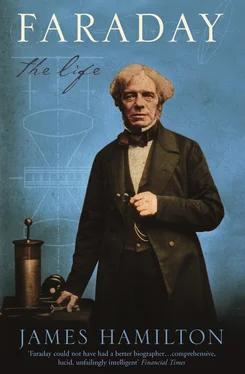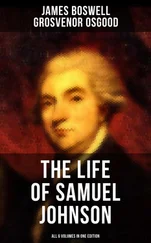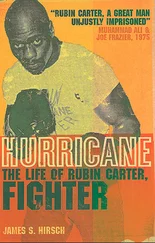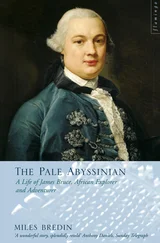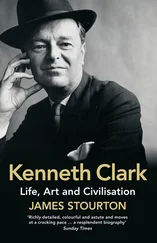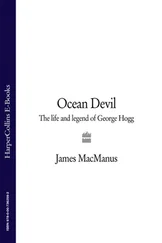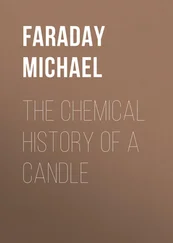Towards the end of 1809 the Faraday family moved from Jacob’s Mews to Weymouth Street, a two-minute run from Riebau’s shop. James Faraday’s ill-health, and the death of his landlady, which may have brought with it further complications in the tenancy, forced him to give up the blacksmithery, and he and his family appear to have exchanged the smithy for 18 Weymouth Street with another tenant. 28James died in 1810, and George Riebau took his place as the father figure to lead Michael Faraday and to broaden his outlook. One lifelong friend, the painter and inventor of optical drawing instruments Cornelius Varley, who was also briefly a member of the Sandemanian church, remembered the young Michael Faraday well: ‘he was the best bookworm for eating his way to the inside; for hundreds had worked at books only as so much printed paper. Faraday saw a mine of knowledge, and resolved to explore it.’ 29
As an example of the right boy being at the right place at the right time, Michael Faraday is comparable in one aspect of his upbringing with the young J.M.W. Turner. Fifteen years earlier, Turner had been a youthful presence in his father’s Covent Garden barber’s shop. The flow that energised him was not one of books, but of customers who passed through the shop and were shown watercolours by the barber’s son. ‘My son is going to be a painter,’ Turner the barber said. Equally, George Riebau’s response was that Michael Faraday’s name ‘I am fully persuaded will be well known in a few years hence’. 30
As a result of Riebau’s encouragement, and the effect of the thousands of books that passed through, or near, his hands, Faraday began in 1809 a collection of ‘Notices, Occurrences, Events Etc relating to the Arts and Sciences’ which he had picked up from newspapers, reviews, magazines and so on. To this collection he gave the title, with its ring of a published collection, ‘The Philosophical Miscellany’ (its contents are listed in Appendix One). He wrote his material out neatly, illustrated it with careful pen-and-ink drawings, and indexed the whole thing. It is an omnivorous and enthusiastic gathering, a clue to the future.
In 1810, when Faraday was nineteen years old, Riebau encouraged him to go to lectures given by the teacher, philosopher and silversmith John Tatum in his house in Salisbury Court, 53 Dorset Street. Faraday’s elder brother Robert found the shilling entry fee for him. 31Tatum’s house was off the eastern end of Fleet Street, a short walk down the hill from the Sandemanian chapel, and thus on one of the Faraday family’s well-trodden routes. The lectures took place on Monday evenings in an upper room where diagrams hung on the walls, and a pair of windows stood opposite Tatum’s desk. We know this because Faraday made a detailed perspective drawing of the empty lecture room, taking it as far as the loops of string suspending the diagrams. There he made friends with other young men and women who were transfixed by the new experimental science. Some, such as Benjamin Abbott and Edward Magrath – both Quakers – and Richard Phillips, became friends for life.
Tatum’s lectures, from which Faraday took notes which he later transcribed and illustrated in detail, covered electricity, galvanism, optics, geology, mechanics, chemistry, astronomy and many other topics, the whole gamut of science, or ‘natural philosophy’. Tatum taught most of what was then known: the gap between basic and advanced scientific research was wafer-thin, and heated disagreements between savants fractured this narrow space. Tatum gave due acknowledgement to his fellow natural philosophers, as scientists were then known, including Professor Humphry Davy, Director of the Laboratory at the Royal Institution, who had demonstrated how water could be decomposed by an electrical current, and Luigi Galvani, who showed how frogs’ legs could be convulsed by an electrical charge. He would demonstrate phenomena with twenty or thirty experiments each evening, all of which Faraday described meticulously in his notes. Some of the experiments went wrong – one evening an electrical charge was too much for a frog, which flew out of its jar and hopped about the room. Other experiments surprised and shocked members of the audience: ‘If any Lady or Gentleman wishes to feel the sensation of the galvanic fluid I should be very happy to accommodate them. They must wet their hand in water and hold one ball in each … hah hah hah hah ha …’. 32
After the shrieks had subsided, Tatum made some more spectacular experiments – by passing an electrical spark through a specially perforated and twisted worm of silver foil he spelt out the word SCIENCE for all to see as the finale to a lecture on Electricity. 33
The lectures were often oversubscribed, with the result that Tatum had to repeat the more popular ones. One of these was ‘Optics, theory and practice’, in which he demonstrated the camera obscura and camera lucida, and showed glass transparencies of landscape and other scenes with a ‘magic lantern’. Tatum’s teaching was essentially visual and demonstrative – he did not only tell his pupils, he showed them. Perhaps using waxed, and thereby transparent, engravings after Joseph Wright of Derby and others, he projected ‘an operation on the air pump … a chemist with a pneumatic trough … a view in a mine in Derbyshire … a gentleman’s mansion’. 34The scientific education that Tatum gave was complete and fascinating, with an emphasis on what would now be called physics; rather less on chemistry. As an offshoot of the lecture series, he invited a group of the men in his audience to meet at his house every Wednesday evening to listen to and give lectures of their own. 35This became formalised in 1808 as the City Philosophical Society, whose members heard Tatum speak and who took it in turns, every other Wednesday, to lecture to the group on scientific subjects that they had studied. 36
Some years after he had transcribed them, Faraday collected his notes of Tatum’s lectures together and bound them in four volumes with a fond, gracious and revealing dedication to Riebau. 37‘Sir,’ he wrote on the dedication page,
When first I evinced a predilection for the Sciences but more particularly for that one denominated Electricity you kindly interested yourself in the progress I made in the knowledge of facts relating to the different theories in existence readily permitting me to examine those books in your possession that were any way related to the subjects then occupying my attention. [To] you therefore is to be attributed the rise and existence of that small portion of knowledge relating to the sciences which I possess and accordingly to you are due my acknowledgements.
Unused to the arts of flattery I can only express my obligations in a plain but sincere way. Permit me therefore Sir to return thanks in this manner for the many favours I have received at your hands and by your means, and believe me your grateful and Obedient Servant, M Faraday.
A close look at the way the pen runs reveals that when Faraday wrote his signature he did the ‘F’ first: thus what he actually wrote was ‘F Maraday’, the manner of his signature, with its mild form of disguise, that he practised all his life.
But long before they were dedicated and bound Riebau had already shown Faraday’s notes to ‘Mr Dance Junr. of Manchester St., who … requested to let him shew them to his Father, I did so, and the next day Mr. Dance very kindly gave [Michael Faraday] an Admission ticket to the Royal Institution Albemarle St.’ 38
The Royal Institution, 21 Albemarle Street, was set up and initially funded by a group of aristocrats, MPs and philanthropists who in 1799 had met to consider urgently ways of speeding the application of newly-evolving scientific principles to the betterment of life for the general population of Britain. The Institution’s mission was put into words by one of the founding fathers, Benjamin Thompson, Count Rumford: ‘for diffusing the knowledge and facilitating the general introduction of useful mechanical invention and improvements, and by teaching by courses of philosophical lectures and experiments the application of science to the common purposes of life’.
Читать дальше
